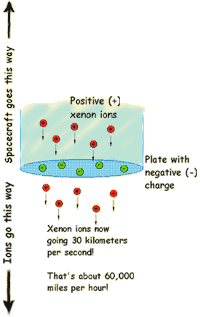How do ion engines work?

How do ion engines work? |
 |
 |
Ion engines typically use xenon gas: a cathode bombards the gas with electrons. The impact of an electron on a xenon atom causes it to lose one of its own 54 electrons. The xenon atoms thus become positively charged ions. At the rear of the engine chamber a pair of metal grids are situated, charged positively and negatively respectively with up to 1,280 volts of electricity. This electrical charge exerts a force on the xenon ions so as to accelerate them out of the engine at about 60,000 mph. The reciprocal thrust moves the engine in the opposite direction. The actual thrust provided by the engine is extemely small, far less than that from chemical rockets. However, the engine can be left running for months or even years (much longer than chemical rockets can run for) and eventually, with no friction or other forces acting, can accelerate the spacecraft to high speeds. |
© jrtait 1998-2000